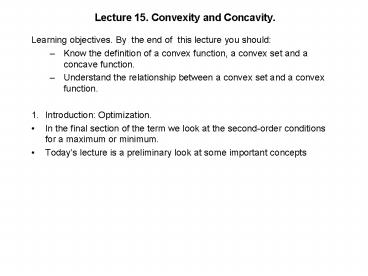Lecture 15' Convexity and Concavity' - PowerPoint PPT Presentation
1 / 16
Title:
Lecture 15' Convexity and Concavity'
Description:
A convex combination of two points is a point that lies on the line between them. ... The third picture shows that the opposite isn't true. ... – PowerPoint PPT presentation
Number of Views:227
Avg rating:3.0/5.0
Title: Lecture 15' Convexity and Concavity'
1
Lecture 15. Convexity and Concavity.
- Learning objectives. By the end of this lecture
you should - Know the definition of a convex function, a
convex set and a concave function. - Understand the relationship between a convex set
and a convex function. - Introduction Optimization.
- In the final section of the term we look at the
second-order conditions for a maximum or minimum. - Todays lecture is a preliminary look at some
important concepts
2
1. Introduction.
- First order conditions yield a solution that is
unique and a maximum in the first and fourth
cases. In the second case the conditions yield a
minimum in the third case there is no unique
solution to the first order conditions. - We seek conditions that ensure that a solution to
the first order conditions is a global maximum.
3
2. Preliminaries convex combinations.
- A convex combination of two points is a point
that lies on the line between them. - More formally, consider two points x and x.
- A convex combination x? ?x (1-?)x for 0 ?1
- E.g. ?0 then x? x ?1 then x? x
- A strictly convex combination x? ?x (1-?)x
for 0 lt?lt1
4
3. Convex sets.
- A convex set, X, is such that for any two
elements of the set, x and x any convex
combination of them is also a member of the set. - More formally, X is convex if for all x and x e
X, and 0 ?1, x? ?x (1-?)x e X. - Sometimes X is described as strictly convex if
for any 0 lt ? lt1, x? is in the interior of X
(i.e. not on the edges) - e.g. convex but not strictly convex
5
3b. Convex sets.
U
U(x) U
p1x1p2x2 m
6
3c. Non-Convex sets.
U
U(x) U
7
4. Exercise which of these sets is convex?
- The set of real numbers.
- (x1,x2) x1x2 2
- (x1,x2) x1x2 2
8
5. Convex functions.
- Convex functions are defined as follows.
- f(x) is convex if given any x, x , x? ?x
(1-?)x where 0 ?1, f(x?) ?f(x)
(1-?)f(x) - loosely the line joining x and x lies above the
function, f.
?f(x) (1-?)f(x)
f(x)
x
x
x
9
5. Convex functions.
- f(x) is convex if given any x, x , x? ?x
(1-?)x where 0 ?1, f(x?) ?f(x)
(1-?)f(x)
x
x
x
10
5. Strictly convex functions.
- f(x) is strictly convex if given any x, x , x?
?x (1-?)x where 0 lt?lt1, f(x?) lt ?f(x)
(1-?)f(x) - Strict convexity implies convexity.
convex, but not strictly convex
strictly convex and convex
x
x
x
not convex or strictly convex
11
6. Quasi-convex functions.
- f(x) is quasi-convex if given any y the set S
x f(x) y is convex. - Note that a convex function is also quasi-convex.
- The third picture shows that the opposite isnt
true. - Were not going to say much more about
quasi-convex, but it is the feature which
guarantees a unique minimum.
y
S
12
7. convex and quasi-convex.
- f(x) is strictly convex if given any x, x , x?
?x (1-?)x where 0 lt?lt1, f(x?) lt ?f(x)
(1-?)f(x) - f(x) is convex if given any x, x , x? ?x
(1-?)x where 0 ?1, f(x?) ?f(x)
(1-?)f(x) - f(x) is quasi-convex if given any y the set S
x f(x) y is convex. - a convex function is also quasi-convex.
- Proof.
- Suppose f is convex and take some y.
- Consider the set S x f(x) y .
- Take x, x e S and any ? where 0 ?1 and so
construct x? ?x (1-?)x . - S is convex if x e S, in other words if f(x)
y. But by convexity f(x) ?f(x) (1-?)f(x)
and by the definition of x and x, f(x) y and
f(x) y, - So f(x) ?f(x) (1-?)f(x) ?y (1-?)y y
- i.e. f(x) y
- So x e S and therefore f is quasi convex
13
8. Concave functions.
- f(x) is concave if given any x, x , x? ?x
(1-?)x where 0 ?1, f(x?) ?f(x)
(1-?)f(x) - loosely the line joining x and x lies below the
function, f.
f(x)
?f(x) (1-?)f(x)
x
x
x
14
5. Strictly concave functions.
- f(x) is strictly concave if given any x, x , x?
?x (1-?)x where 0 lt?lt1,
f(x?) gt ?f(x) (1-?)f(x) - Strict concavity implies concavity.
concave, but not strictly concave
strictly concave and concave
x
x
x
not concave or strictly concave
15
6. Quasi-concave functions.
- f(x) is quasi-concave if given any y the set S
x f(x) y is convex. - Note that a concave function is also
quasi-concave. - The third picture shows that the opposite isnt
true. - Were not going to say much more about
quasi-concave, but it is the feature which
guarantees a unique maximum.
y
S
16
Concave sets.
- Draw a concave set here.































